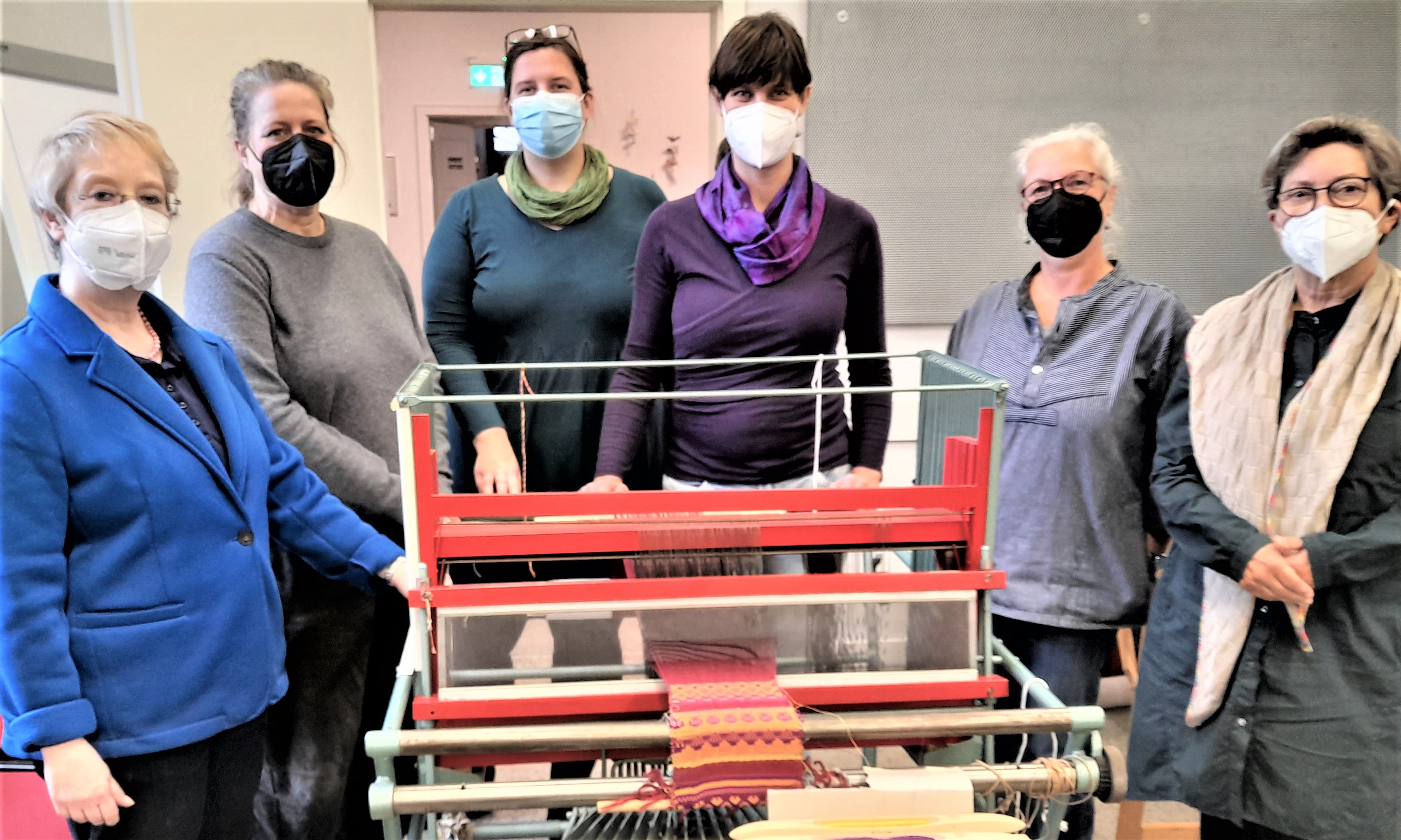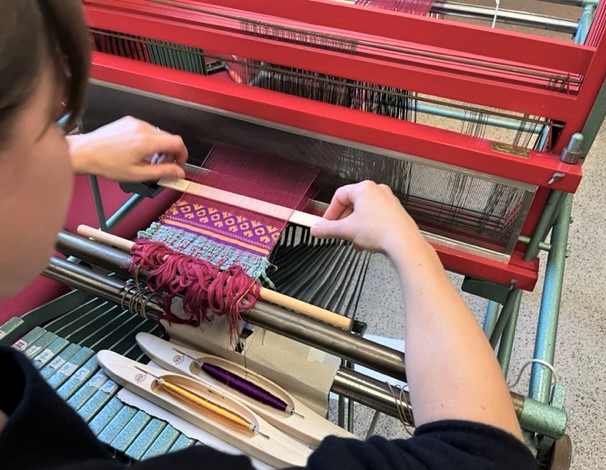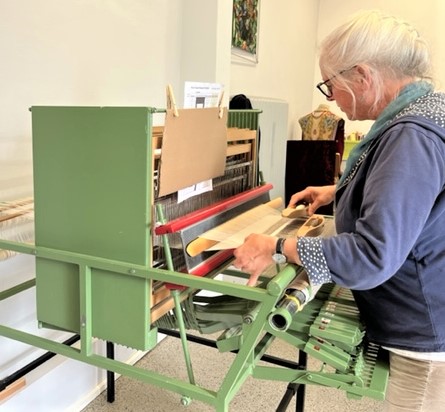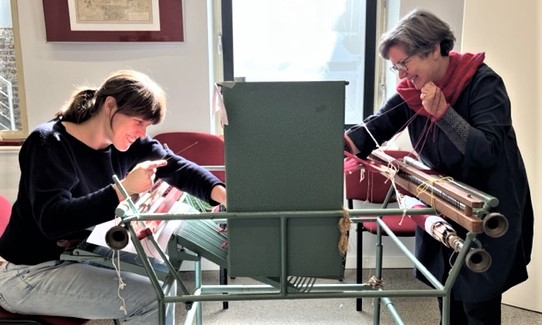Textile and silk museum invited to Krefeld
"Recreating antique silk luster" was the goal and at the same time the title of a very special weaving course that was now offered jointly by the German Textile Museum and the Haus der Seidenkultur (HdS) - the former parament weaving workshop of Hubert Gotzes. Specialists from the Netherlands, Belgium, the Czech Republic and the rest of Germany met in the oldest jacquard hand-weaving room in Europe on Luisenstrasse to learn more about antique silk fabrics and their weaving methods in Krefeld.
For a week, the antique fabrics were analyzed together, patterns designed, looms prepared and examples woven. Dipl. Engineer Dieter Blatt and his HdS team of volunteers created the framework for the course, which was led by textile archaeologist Barbara Thomas, in the former parament weaving workshop Hubert Gotzes.
The course was initiated by Dr. Annette Paetz called Schieck, Director of the German Textile Museum in Krefeld. The project and course would not have been possible without the fascinating ancient examples that lie dormant in the museum's archive. The foundations for the current course were laid back in 2019, where the patterns of antique fabrics were translated to modern looms and brought back to life through their detailed reweaving. The project was made possible by funding from the Sparkassen-Kulturstiftung Krefeld.

The course was aimed at experts from museums and collections with textiles that are more than a thousand years old, as well as at experienced weavers. The specialists came to Krefeld from Amsterdam, Brussels, Prague, Lake Constance and Cologne to find out more about antique silk fabrics and their weaving methods and to learn how to reweave them on modern handlooms.
Samit and taqueté are the names of the techniques used for the multicolored fabrics. Not only one batch of warp threads is stretched for the fabric, but two. Textiles with woven meanders, medallions and entire picture stories were created with an ingenious system of weave and pattern. “It was incredibly complex to produce these fabrics. Not only the materials are very fine, but also the weaving technique requires a lot of attention. At that time, the looms were specially equipped for such patterned fabrics, but you still only managed a few centimeters a day,” explains course instructor Barbara Thomas.
A weaving loom was specially converted for the course in the House of Silk Culture: the participants were able to create their own designs using a very special facility between the comparatively young jacquard machines of the 19th century. For this purpose, so-called nail shafts were built into a simple loom: They make it possible to control each individual thread for a pattern. A fabric is currently being created that shows the word “silk culture” in large letters. This is time-consuming and it quickly becomes clear why the invention of the jacquard machine at the beginning of the 19th century triggered such a revolution. "Unfortunately, we do not know exactly what the looms for the patterned fabrics looked like 1,500 years ago, as no looms or drawings of them have survived. That's why we approach the technology with modern but simple weaving equipment." explains the textile archaeologist.

Unbelievable how people did that back then!
During the practical part, Dieter Blatt and Ina Matoni from the HdS are on hand with help and advice. And there was a lot of weaving: In the House of Silk Culture, the participants were able to try out different techniques on five modern hand looms. Sometimes there are detailed antique patterns in fine yarns, sometimes there was the opportunity to realize your own designs in shiny silk. There was a lot of talk shop about the ancient techniques and some tricks from everyday work in modern hand weaving were exchanged. "It's incredible how people did it back then. If you try it yourself, you get an understanding of the treasures of such fabrics.” adds one participant.
A visit to the textile museum increases respect for the originals: “Now that you have understood the technical side of the textiles, they are even greater!” confirms the weaver from Cologne. director dr Annette Paetz took extra time to discuss the special features of the fabrics with the participants and to show the tradition of reconstruction.

Krefelder tissue collection
Already in the earliest beginnings of the Krefeld fabric collection under the then director Paul Schulze, reproductions of the fascinating antique silks were made. “The Krefeld tissue collection was created at the end of the 19th century for the purpose of training the trainees of the tissue school, allowing them to analyze techniques and inspiring them. Perhaps the reweaving that we have from that time is also one of the tasks that the students had to master at the time," explains the director.
At the end of the course, all participants proudly hold their self-woven samples in their hands. A little exhaustion can be felt after the intensive week, but the joy on the faces clearly outweighs it. The sample pieces are by far not the only thing that the participants from Krefeld take with them: “The small practice pieces are something very special for me. Design a pattern, see how laboriously it grows and how the draft can be transferred from paper to textile,” summarizes one participant.
And: “It fills me with great awe to think of the originals with what I have now experienced. Knowing that they were created without box paper, microscope, daylight lamps and corrective lenses. I take with me so much knowledge about the complex weaving techniques, great contacts and even more enthusiasm for what I do every day.”
Conclusion of the course graduates: “We have seen, experienced and learned so much. It was a very unusual course that will certainly have an impact for a long time to come.”
According to the participants, the course not only shone with textiles, but also with the unique combination of specialist knowledge and practical work, which is only possible in Krefeld. Will there be a continuation of the courses? When it comes to the participants: “Absolutely! Krefeld still has a lot of textile history(s) to offer!”

